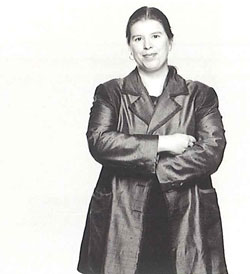Joana Vasconcelos Paris ¶ 1971
| |
 |
| |
Créditos fotográficos / Photographic credits:
Abílio Leitão |
She studied at Ar.Co from 1989 to 1996, and at IADE, in Lisbon, from 1991 to 1992. In 2000 she was given the New Artists EDP Award and in 2003 she was awarded the Tabaqueira Fund for Public Art, for her intervention project in the Largo da Academia das Belas Artes (Lisbon). Since 1994 she has regularly exhibited her work, both nationally and internationally, and she has recently achieved a high level of international recognition, especially through her participation at the 2005 Venice biennial. ¶ From the outset of her career Vasconcelos has used variegated daily objects, transforming and organizing them in order to create the most unexpected of sculptures, constructions, and atmospheres. These are in point of fact sculptures - forms in space i.e., - but Vasconcelos's work is quite remote from traditional understandings of sculpture, plunging right into the highbrow/lowbrow art dichotomy, by alluding to kitsch or pop source material. The examples range from the funnels-cum-monument in Tolerância Zero (Zero Tolerance, 1999), the multitude of objects that become the focus of a voyeuristic contemplation, enclosed in a glass box with blinds in Vista Interior (Inner View, 2000), the dusters that encircle a sensual space in Flores do meu Desejo (The Flowers of my Desire, 1996), the OB tampons which invoke a candid universe in Noiva (Bride, 2001, and re-presented at the Venice biennial in 2005), to the fur coats that bring some warmth in opposition to the coldness suggested by the refrigerators' doors in Menu do Dia (Day's Menu, 2001). ¶ The suppleness with which the artist uses such unexpected materials and objects - unexpected in artistic practice, that is - is probably due to the fact that prior to her engagement with the visual arts scene she studied jewellery and design, developing a very acute receptivity towards the playfulness of the different sizes as well as the possible disruptions of an object's appointed functions, not to mention an enhanced conscience of the alluring efficiency of its colours and contrasts. ¶ Her work indicates both the evidence of presence and the power of communication. It is impossible not to grasp this facet, given the fact that these works are able to convey to us the screaming echoes of reality itself, from beyond the flamboyant and spectacular façade that we're confronted with in the first place. In 2006 Vasconcelos made the sculpture Néctar, a commission by the Berardo Foundation for the main entrance of the exhibition centre of the Centro Cultural de Belém.



